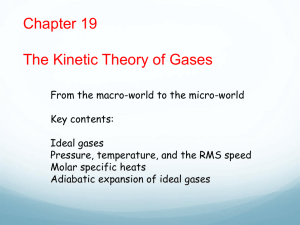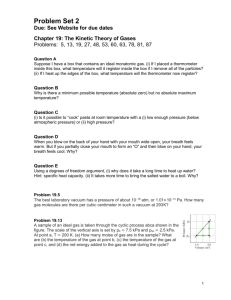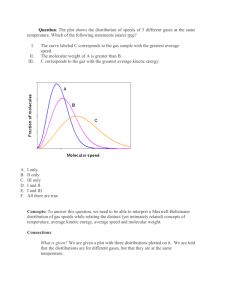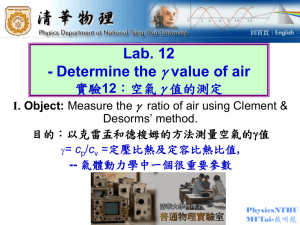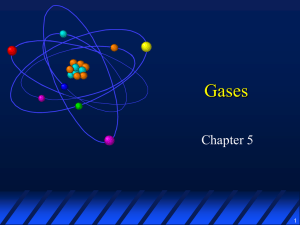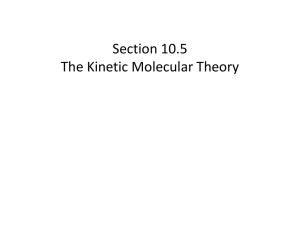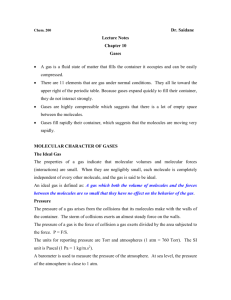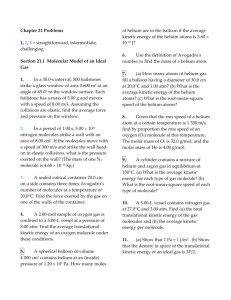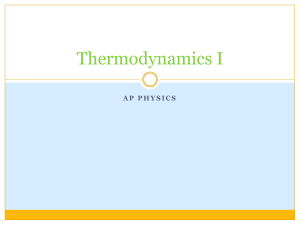Halliday-ch19
advertisement
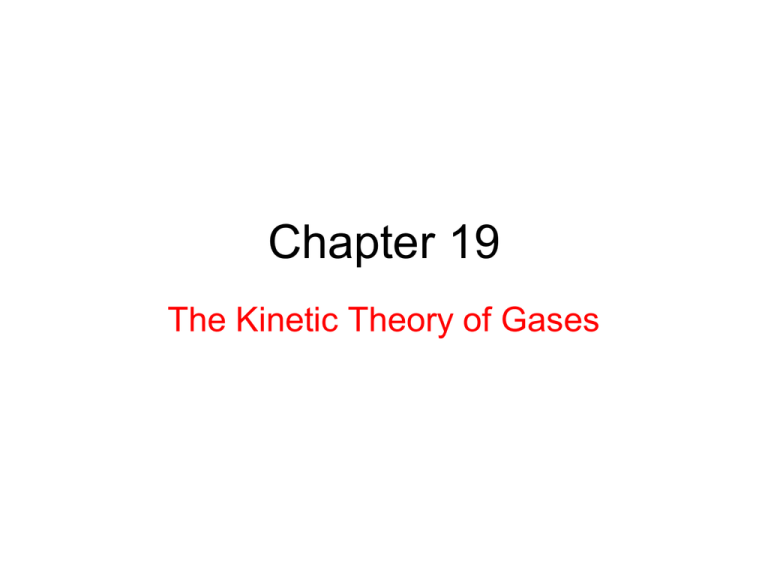
Chapter 19 The Kinetic Theory of Gases 19.2 Avogadro’s Number One mole is the number of atoms in a 12 g sample of carbon-12. The number of atoms or molecules in a mole is called Avogadro’s Number, NA. If n is the number of moles contained in a sample of any substance, N is the number of molecules, Msam is the mass of the sample, and M is the molar mass, then 19.3: Ideal Gases Here p is the absolute pressure, n is the number of moles of gas present, and T is its temperature in kelvins. R is the gas constant that has the same value for all gases. Here, k is the Boltzmann constant, and N the number of molecules 19.3: Ideal Gases; Work Done by an Ideal Gas at Constant Temperature 19.3: Ideal Gases; Work Done at Constant Volume and Constant Pressure W done by an ideal gas (or any other gas) during any process, such as a constantvolume process and a constant-pressure process. If the volume of the gas is constant, If, instead, the volume changes while the pressure p of the gas is held constant, 19.4: Pressure, Temperature, and RMS Speed For a typical gas molecule, of mass m and velocity v, that is about to collide with the shaded wall, as shown, if the collision with the wall is elastic, the only component of its velocity that is changed is the x component. The only change in the particle’s momentum is along the x axis: Hence, the momentum Dpx delivered to the wall by the molecule during the collision is +2mvx. The time Dt between collisions is the time the molecule takes to travel to the opposite wall and back again (a distance 2L) at speed vx.. Therefore, Dt is equal to 2L/vx . Therefore, The pressure: But, Therefore, With we finally have and 19.4: RMS Speed 19.5: Translational Kinetic Energy 19.6: Mean Free Path The mean free path, l, is the average distance traversed by a molecule between collisions. The expression for the mean free path does, in fact, turn out to be: 19.7: The Distribution of Molecular Speeds Maxwell’s law of speed distribution is: Here M is the molar mass of the gas, R is the gas constant, T is the gas temperature, and v is the molecular speed. The quantity P(v) is a probability distribution function: For any speed v, the product P(v) dv is the fraction of molecules with speeds in the interval dv centered on speed v. The total area under the distribution curve corresponds to the fraction of the molecules whose speeds lie between zero and infinity, and is equal to unity. Fig. 19-8 (a) The Maxwell speed distribution for oxygen molecules at T =300 K. The three characteristic speeds are marked. 19.7: Average, RMS, and Most Probable Speeds The average speed vavg of the molecules in a gas can be found in the following way: Weigh each value of v in the distribution; that is, multiply it by the fraction P(v) dv of molecules with speeds in a differential interval dv centered on v. Then add up all these values of v P(v) dv. The result is vavg: Therefore, leads to RMS speed: The most probable speed vP is the speed at which P(v) is maximum. To calculate vP, we set dP/dv =0 and then solve for v, thus obtaining: Example, Speed Distribution in a Gas: Example, Different Speeds 19.8: Molar Specific Heat of Ideal Gases: Internal Energy The internal energy Eint of an ideal gas is a function of the gas temperature only; it does not depend on any other variable. 19.8: Molar Specific Heat at Constant Volume where CV is a constant called the molar specific heat at constant volume. But, Therefore, With the volume held constant, the gas cannot expand and thus cannot do any work. Therefore, When a confined ideal gas undergoes temperature change DT, the resulting change in its internal energy is A change in the internal energy Eint of a confined ideal gas depends on only the change in the temperature, not on what type of process produces the change. 19.8: Molar Specific Heat at Constant Pressure , 19.8: Molar Specific Heats Fig. 19-12 The relative values of Q for a monatomic gas (left side) and a diatomic gas undergoing a constant-volume process (labeled “con V”) and a constantpressure process (labeled “con p”). The transfer of the energy into work W and internal energy (Eint) is noted. 19.9: Degrees of Freedom and Molar Specific Heats Every kind of molecule has a certain number f of degrees of freedom, which are independent ways in which the molecule can store energy. Each such degree of freedom has associated with it—on average—an energy of ½ kT per molecule (or ½ RT permole). 19.9: Degrees of Freedom and Molar Specific Heats 19.10: A Hint of Quantum Theory 19.11: The Adiabatic Expansion of an Ideal Gas Starting from: And using the result for Eint, we get: From the ideal gas law, Also, since CP-CV = R, Using the above relations, we get: Uisng g = CP/CV, and integrating, we get: Finally we obtain: 19.11: The Adiabatic Expansion of an Ideal Gas 19.11: The Adiabatic Expansion of an Ideal Gas, Free Expansion A free expansion of a gas is an adiabatic process with no work or change in internal energy. Thus, a free expansion differs from the adiabatic process described earlier, in which work is done and the internal energy changes. In a free expansion, a gas is in equilibrium only at its initial and final points; thus, we can plot only those points, but not the expansion itself, on a p-V diagram. Since Eint =0, the temperature of the final state must be that of the initial state. Thus, the initial and final points on a p-V diagram must be on the same isotherm, and we have Also, if the gas is ideal, Four Gas Processes for an Ideal Gas
